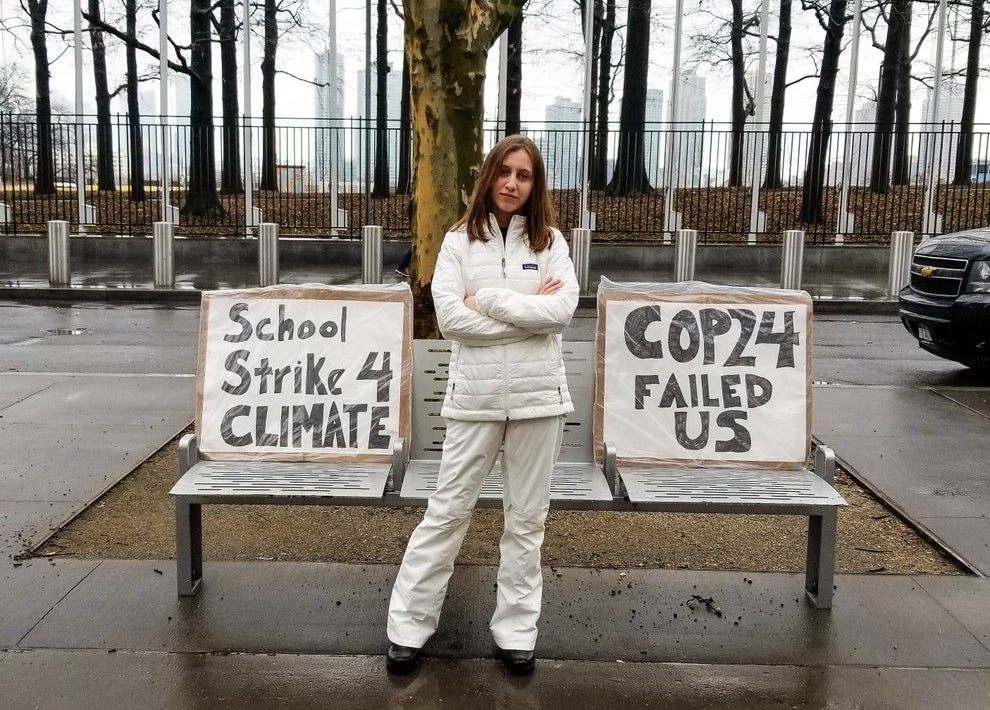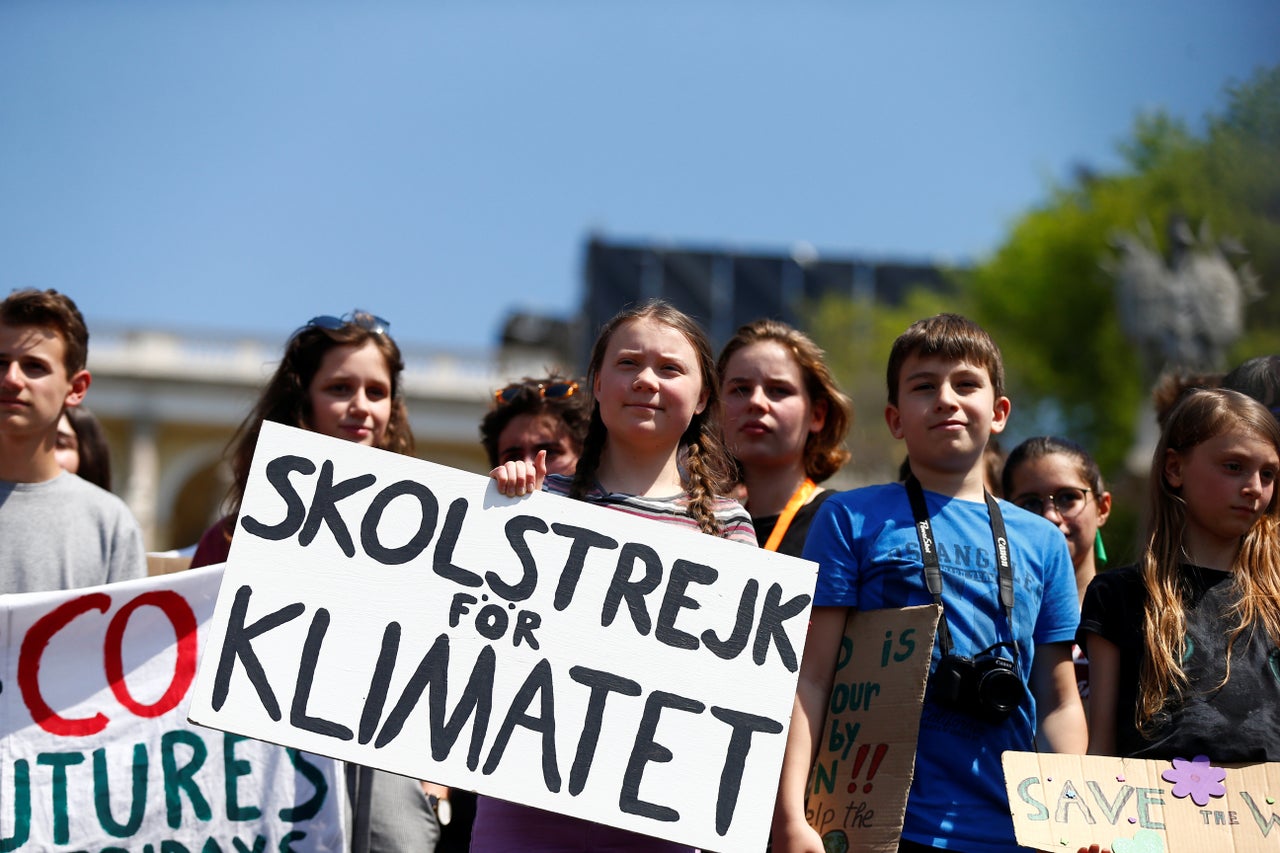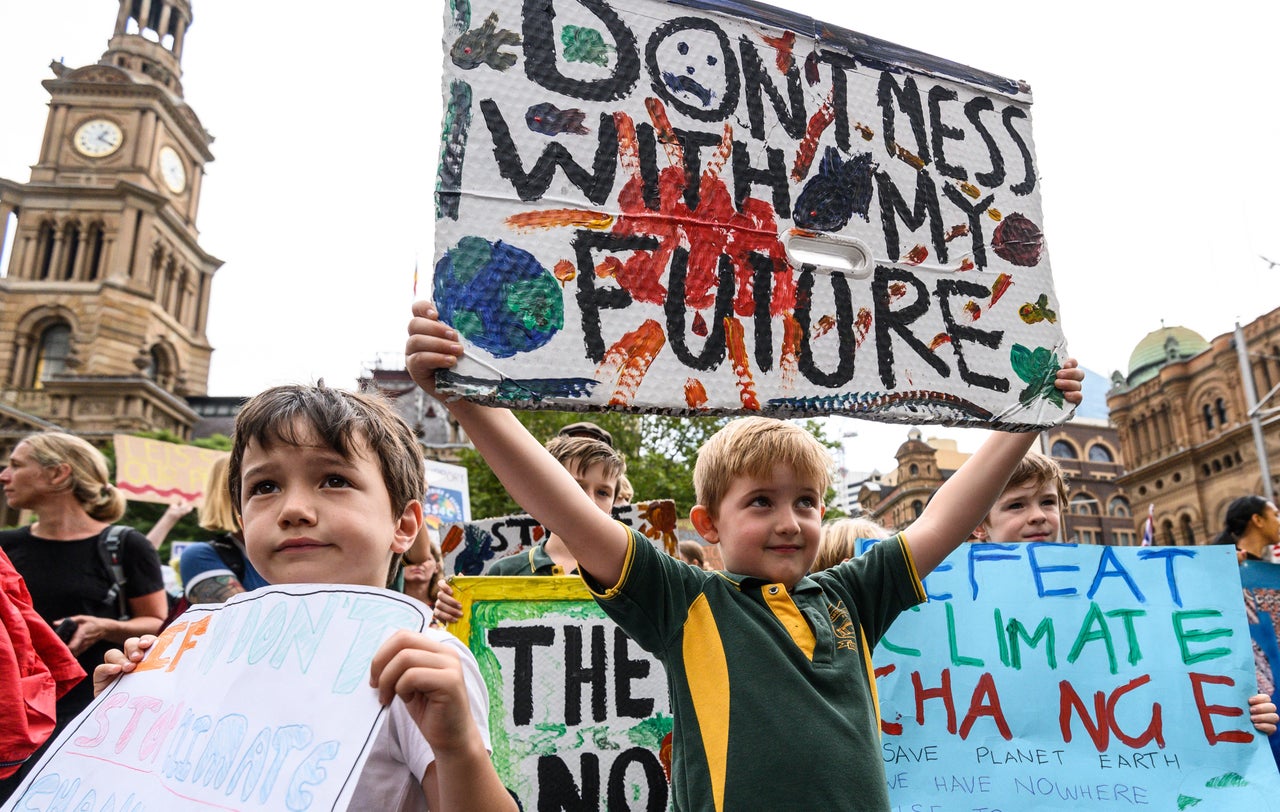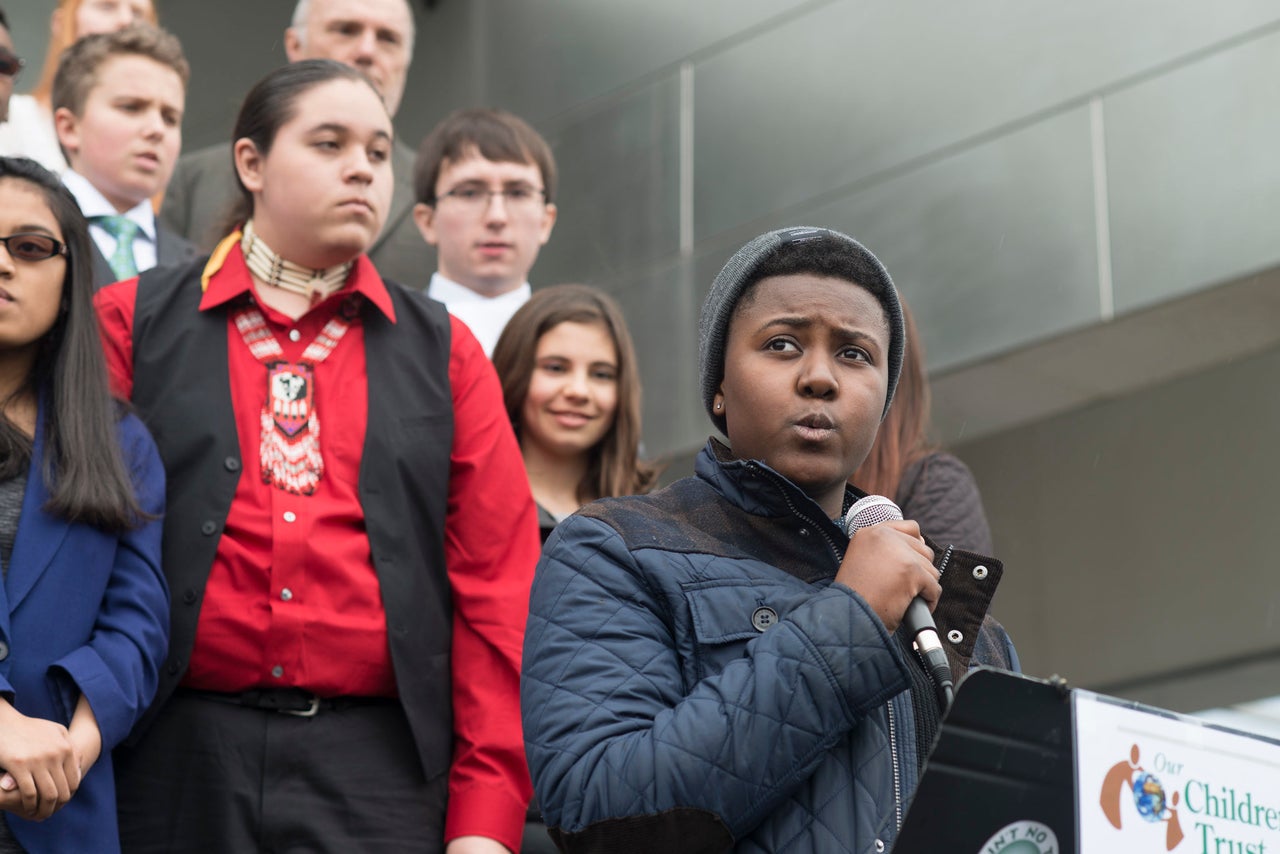It didn’t take long for the death threats to start. Alexandria Villaseñor, a 13-year-old environmental activist, had just been featured in an Agence France-Presse article republished by Breitbart News about dozens of students staging a “die-in” at United Nations headquarters in New York.
Villaseñor was protesting that day in mid-March for the same reason that she decided to start a school strike four months earlier: to demand that world leaders quit dragging their feet and take swift action to combat global climate change.
“Don’t stage it, just die,” one Breitbart reader commented on the right-wing publication’s website. “I would be more impressed if they doused theselves with gas and set themselves on fire,” wrote another. “You don’t deserve a future, you pathetic halfwit,” said a third.
The repugnant online trolling might send most seventh graders cowering, but Villaseñor shrugged it off. Her fight is about ensuring that her generation and future ones are left with a habitable planet. She wasn’t about to let a bunch of angry deniers get in the way.
“I think if more people really understood the climate science, the extinction rate and just all the terrible statistics about what we’re doing to our planet, they would be motivated, too,” she told HuffPost. “If everyone just paid attention to the facts, everyone would be a climate activist.”
The last five years were the five hottest on record. The amount of carbon dioxide in the atmosphere has soared past 410 parts per million ― a concentration that hasn’t been seen in 3 million years, when sea levels were up to 66 feet higher, according to a recent study. Human-caused climate change is driving sea-level rise, drought, extreme weather and a biodiversity crisis that scientists have declared Earth’s sixth mass extinction event. As many as 150 species die off each day.
Monday is Earth Day, the 49th anniversary of the birth of the modern environmental movement and a day of action celebrated by more than a billion people around the globe.

Villaseñor has emerged as a leader within the youth climate movement ― a movement that scientists say has moved the needle on action to address the climate emergency.
Her debut in activism came after a life-changing trip last November to visit family in Davis, California, where she was born and raised. During her visit, the state experienced its deadliest and most-destructive fire on record. The blaze, named the Camp fire, torched more than 153,000 acres, destroyed nearly 19,000 structures and killed at least 86 people. The town of Davis was choked by a thick blanket of smoke. Villaseñor, who suffers from asthma, was forced to cut her trip short.
“Once I got back to New York City, I was really upset,” she said. The teen started researching climate change, made the connection that the crisis is a driver of catastrophic fires and extreme weather, and came to the sobering realization that her generation would bear the brunt of decades of global inaction. In that process, she found Greta Thunberg.
Thunberg, a 16-year-old Swedish environmental activist, went on strike from school last year after Sweden experienced its hottest summer on record. For weeks she sat outside her country’s parliament, holding a “School strike for climate” sign and demanding that local politicians enact policies in line with the goals of the 2015 Paris Agreement on climate action. She passed out flyers that read, “I am doing this because you adults are shitting on my future.”
She has also taken repeated swings at world leaders, including during a speech at the U.N. climate conference in Poland last December.
“You are not mature enough to tell it like it is,” Thunberg said. “Even that burden you leave to us children. But I don’t care about being popular. I care about climate justice and the living planet.”

Thunberg’s Fridays for Future movement inspired Villaseñor and hundreds of thousands of other students around the globe. An estimated 1.4 million young people in more than 100 countries went on strike from school March 15. Villaseñor organized U.S. strikes along with Isra Hirsi, the 16-year-old daughter of Rep. Ilhan Omar (D-Minn.), and Haven Coleman, a 13-year-old from Colorado.
Villaseñor is nearly 20 weeks into her own strike. Instead of going to school on Fridays, she protests outside U.N. headquarters in New York City, almost always alone and often in the rain and cold. She sits on a bench with a pair of signs, one on each side of her, that read “School strike 4 climate” and “COP24 failed us,” a reference to the December climate conference in Poland.
Villaseñor says American schools have also failed to inform students about the urgent, existential threat the world is facing.
“Why go to school if we’re going to be in the future running from the next extreme weather events?” she asked. “I’ve been learning more protesting at the U.N. than I would at school.”
Villaseñor and other up-and-coming climate leaders have faced plenty of criticism.
When 29-year-old freshman congresswoman Alexandria Ocasio-Cortez (D-N.Y.) introduced the Green New Deal in February, a nonbinding climate resolution to rapidly decarbonize the U.S. economy, senior Republicans were quick to dismiss it as a pie-in-the-sky proposal ― “tantamount to genocide,” one said ― from a naive young lawmaker.
“You only have to be 25 years old to be a member of Congress,” Rep. Doug Lamborn (R-Colo.), 64, said at a congressional hearing in February. “We have young people that bring a lot of great qualities, but maybe they don’t bring a lot of life experience.”
When a group of children ages 7 to 16 showed up in February at Sen. Dianne Feinstein’s office in San Francisco to demand that she support the Green New Deal resolution, the 85-year-old Democrat lectured them and argued.
“I’ve been doing this for 30 years. I know what I’m doing,” the senator told them. “You come in here and you say it has to be my way or the highway. I don’t respond to that.”
And when students went on strike from schools around the world in March, people in power insisted they were out of line. British Prime Minister Theresa May, 62, criticized students for wasting valuable class time, and an Australian education minister warned that children and teachers would be punished for participating in March 15 rallies.
“We hear you. And we don’t care,” Thunberg wrote on Twitter in response to the Australian official’s demands. “Your statement belongs in a museum.” (Thunberg has since been nominated for a Nobel Peace Prize.)
That hopeful day of action was ultimately overshadowed by tragedy. In Christchurch, New Zealand, just a few miles from where thousands of students were striking, a gunman opened fire on two mosques, killing 50 people in the worst mass shooting in the nation’s history.
“The young people who took part in the #climatestrike, you gave us hope on a dark day,” the New Zealand chapter of the environmental group Greenpeace wrote in a post to Twitter. School Strike 4 Climate NZ, the organization that coordinated strikes in New Zealand, vowed to continue to build momentum. “The forces of hate and exploitation of people and of the environment cannot be separated ― this is one fight,” the group wrote in a series of posts.

Some older Americans, those of generations largely responsible for today’s crisis, may shrug at vocal, persistent youngsters trying to change the status quo. But this activism and pressure were born out of a feeling of desperation, and the youth on the front lines of this fight for a more sustainable future have made it clear they’re here to stay.
“The youth movement, it will get more radical,” Villaseñor said. “We’ll continue to go outside of the system, because a lot of us realize we can’t change a broken system within the system. We’ll have larger protests.”
The science and scientists are on their side.
Michael Mann, a climate scientist at Pennsylvania State University, told HuffPost that incremental actions won’t be enough to prevent dangerous planetary warming, that it requires a massive international mobilization.
“That’s what I see these kids doing ― creating a groundswell of demand for that mobilization,” Mann wrote in an email. “They speak with a moral clarity and determination that is unmatched by anyone or anything else.”
The Intergovernmental Panel on Climate Change, the leading U.N. consortium of researchers studying anthropogenic planetary warming, issued a dire report in October warning world governments that they have just 12 years to stave off potentially irreversible climate change. Without swift action to overhaul the global economy and rein in carbon emissions, the IPCC said, humans will soon live in a world where coastal cities are inundated by rising seas, oceans are largely devoid of tropical corals, and drought, extreme weather and wildfires wreak havoc. The report pegged the cost of climate-related damages that would result from global warming of 1.5 degrees Celsius above pre-industrial levels at $54 trillion.
It was a wake-up call that galvanized young people. And this month, thousands of scientists signed onto a letter, posted in Science magazine, in support of the youth protests. The authors wrote that the activists’ “concerns are justified and supported by the best available science” and that “without bold and focused action, their future is in critical danger.”
Katharine Hayhoe, director of the Climate Science Center at Texas Tech University and a co-author of the letter, said the movement is “an important inflection point that has changed the dialogue.” Youth are passionate, honest and “bring much-needed energy, urgency and hope to the conversation,” she said.
As Hayhoe sees it, the shift started with the landmark lawsuit that 21 children and young adults from around the country brought against the United States. The complaint, filed by the nonprofit Our Children’s Trust, asserts that the federal government is violating the youth plaintiffs’ constitutional rights to life, liberty and property by promoting fossil fuel production and failing to take action on climate change.
“It’s very much that same spirit that motivates the climate strikes, that this is our world and the choices you are making we do not agree with,” Hayhoe said. “And we are the ones who have to pay for your choices, and that is not fair.”
Originally filed in 2015 against the Obama administration, the lawsuit, called Juliana v. U.S., now targets the Trump administration, which has worked hard to derail U.S. actions to combat climate change. Plaintiff Vic Barrett, a 20-year-old first-generation Honduran American from White Plains, New York, joined the lawsuit as a way to fight for climate justice at a time when she was still too young to vote. She told HuffPost it’s been amazing to watch the engagement of young people explode over the last year. It’s the sort of moment that she’s been waiting to see since she got into activism at age 14.
“We’ve seen that young people are just saying, ‘This is the future we want and we’re going to do anything possible to get that,’” she said. “And I think that’s a huge motivator, knowing that I’m not alone doing it.”

After being thrust into the national spotlight, climate change looks poised to be a major issue in the 2020 election. A recent poll found that 84% of likely Democratic voters in five early primary states ranked addressing the climate crisis as “essential” or “very important.” All Senate Democrats running for the White House are co-sponsors of the Green New Deal. Sen. Elizabeth Warren (D-Mass.) unveiled Monday an ambitious policy proposal to protect public lands that includes a ban on new oil and gas leases on federal lands and in U.S. waters. That same day, Sen. Bernie Sanders (I-Vt.) released his own climate platform, which calls for a ban on fracking, new fossil fuel infrastructure, and oil, gas and coal leases on federal land, as well as stopping all exports of fossil fuels.
It’s these sort of ambitious initiatives that groups like Sunrise Movement, the youth-led climate advocacy group that stormed Democratic leaders’ offices last year to garner support for the Green New Deal, expect from political candidates. On Thursday, Sunrise launched its Road to a Green New Deal Tour, an eight-stop speaking event to boost support for the already wildly popular climate policy. The tour includes stops in several states, including Michigan, Louisiana and Kentucky.
With scientists making it clear that there is little time to act, Sunrise is focused on holding all politicians’ “feet to the fire,” Stephen O’Hanlon, the group’s 23-year-old co-founder, told HuffPost.
“It’s no longer acceptable for politicians who say they want to take action on climate change to just acknowledge the science and propose piecemeal solutions,” O’Hanlon told HuffPost. “If they want to be taken seriously by our generation, they need to back solutions that actually take action.”
